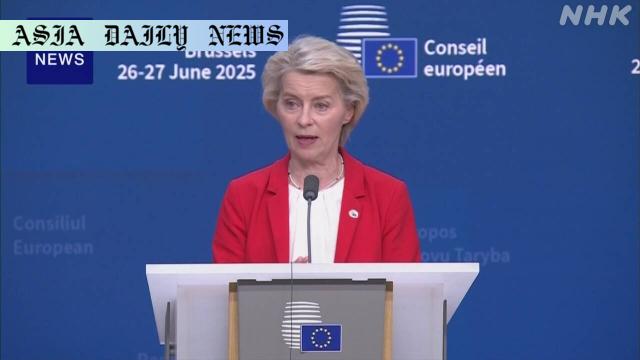EU-Asia Trade Cooperation: Von der Leyen proposes partnerships in free trade, suggesting collaboration as a path to WTO reform.
Von der Leyen suggests EU-Asia trade collaboration for free trade.
Mentions CPTPP as a vital trade pact and basis for WTO reform.
EU seeks to lead global trade without US reliance.

Introduction: EU’s Vision for Trade Cooperation
The landscape of global trade is undergoing transformative shifts, with key players reassessing and redefining their roles in maintaining economic order. Amidst this backdrop, Ursula von der Leyen, the President of the European Commission, has introduced a forward-looking narrative about EU-Asia trade collaboration. At a European Union summit held on Thursday, von der Leyen shared her vision of structured economic cooperation between the EU and Asian countries as a foundation for redesigning the World Trade Organization (WTO). Her insights have garnered significant attention, particularly as they propose a fresh perspective on the evolving dynamics of globalization.
The CPTPP: A Model for Global Trade Cooperation
A cornerstone of von der Leyen’s proposal lies in her reference to the Comprehensive and Progressive Agreement for Trans-Pacific Partnership (CPTPP). This trade pact has become an exemplar of multilateralism, uniting Asia-Pacific nations in robust economic collaboration. Von der Leyen deemed the CPTPP “most attractive and interesting,” recognizing its potential as a model for expanding multilateral trade frameworks. The suggestion marks a strategic EU interest in aligning with Asia’s most significant trade bodies, emphasizing the need for actionable partnerships that extend beyond regional boundaries.
Restructuring the World Trade Organization
Von der Leyen’s remarks suggest that the EU is leaning toward a leadership role in reconstructing the WTO. The proposal comes at a time when the global trade order faces disruptions from policies such as former US President Donald Trump’s “America First” agenda. These policies disrupted traditional trade alliances, leading to sweeping tariffs that many argue have jeopardized fair competition and economic stability. The EU’s pursuit of trade ties with Asia could thus be a strategic maneuver to fill the void left by erratic US participation in global trade discourse.
Skepticism and Strategic Posturing
Despite her optimistic rhetoric, there are voices within the EU pointing out the tactical nature of von der Leyen’s stance. Some sources hinted that the comments might be a strategic posturing aimed at influencing US policy and gaining leverage in trade negotiations with Washington. The nuanced undertones of her speech, therefore, suggest a dual agenda—strengthening foundational trade relationships with Asia while indirectly addressing challenges posed by the United States.
Conclusion: Toward a Unified Trade Future
Von der Leyen’s vision underscores a pressing need for a coherent and rules-based global trade system. The emphasis on EU-Asia cooperation reflects a pragmatic approach toward stabilizing global commerce amidst uncertainty. Whether as a genuine commitment or a strategic pose, the dialogue opens avenues for new partnerships, collaborative prosperity, and reformed trade dynamics. As these developments unfold, they hold the potential to redefine economic alliances and the core principles of multilateralism.
Commentary
EU-Asia Collaboration: A Strategic Vision
The European Union’s approach to fostering trade cooperation with Asia is not only strategic but also timely. Ursula von der Leyen’s remarks at the EU summit showcase an ambition rooted in strengthening multilateral trade amidst a fractured global economic order. Over the past few years, the predictable patterns of globalization have given way to uncertain trade dynamics, marked by tensions between major economies. Against this backdrop, the EU’s call for structured collaboration with Asia offers a stabilizing prospect.
The Role of CPTPP in the Future of Free Trade
Referring to the Comprehensive and Progressive Agreement for Trans-Pacific Partnership (CPTPP) underscores the EU’s intention to leverage existing, successful trade models. The CPTPP represents a collection of principles that the EU can adapt to align with its standards and regulations, creating opportunities for mutual growth. As one of the most active trade areas in the world, the Asia-Pacific region represents untapped potential for the EU’s long-term aspirations of economic expansion and geopolitical leverage.
Balancing Global Trade Leadership
The EU’s keen interest in leading global trade without heavy reliance on the United States is both bold and necessary. With America’s withdrawal from key multilateral commitments in recent years, the global trade system has faced significant instability. The EU’s overtures to Asia highlight an adaptive strategy designed to mitigate these challenges and reinforce a unified economic framework. However, convincing wary observers within its own ranks will require not only innovative trade agreements but also solid economic outcomes.
Conclusion: Building a Cohesive Global Trade Network
In conclusion, von der Leyen’s proposal is more than a policy suggestion—it’s an acknowledgment of the EU’s role in reshaping the future of trade partnerships. Amidst rising protectionism and fractured economic alliances, the vision for EU-Asia cooperation presents an opportunity to rewrite outdated rules, establish fairness, and ensure global growth. Whether this vision materializes into actionable policies hinges on collaborative intent and shared objectives among global stakeholders.


